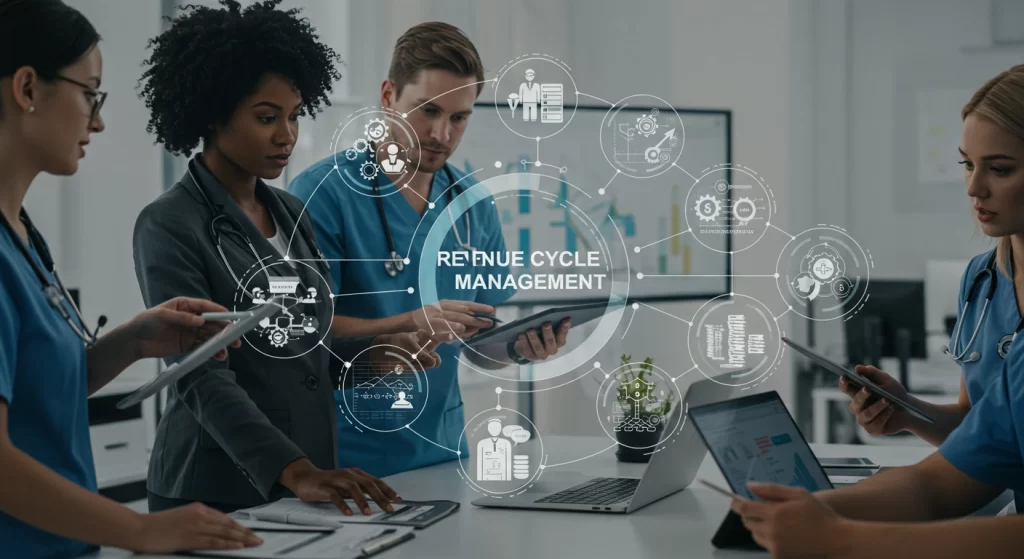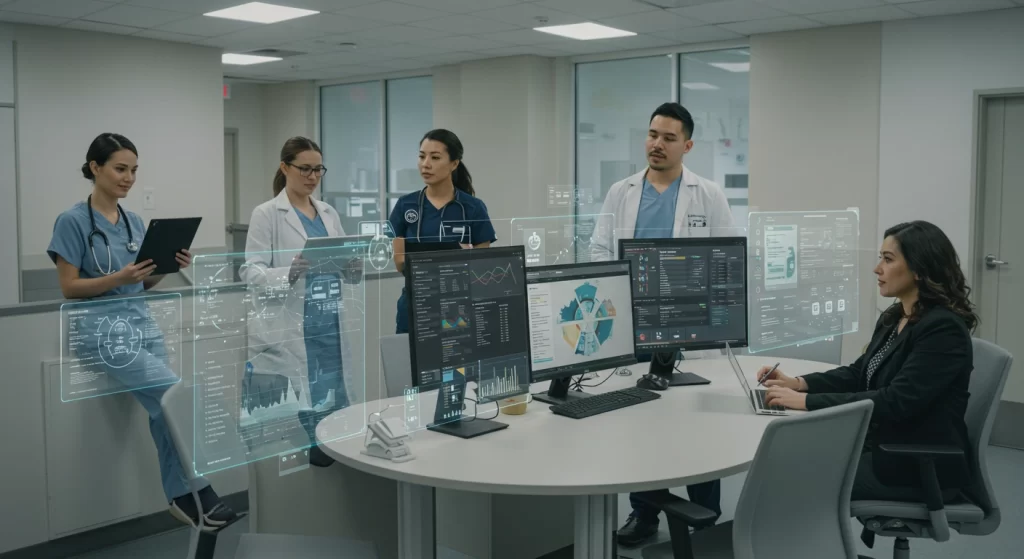The financial health of any healthcare organization relies heavily on efficient revenue management. In today’s complex landscape with evolving payment models and regulations, mastering the financial workflow is crucial. This is where Revenue Cycle Management (RCM) is essential. Effective revenue cycle management healthcare strategies support sustainable, high-quality patient care. This guide explores RCM concepts, stages, technologies like AI in revenue cycle management, strategic choices, and key success metrics.

Ready to optimize your healthcare finances with AI-driven RCM solutions? Contact us today to leverage our expertise in developing healthcare AI platforms!
What is Revenue Cycle Management in Healthcare?
Revenue cycle management (RCM) includes all administrative and clinical functions involved in capturing, managing, and collecting patient service revenue. It represents the financial journey of a patient’s care, starting from scheduling an appointment and ending when the final payment settles the account. It’s a comprehensive process involving people, procedures, and technology.
So, what is revenue cycle management in healthcare specifically? It’s the systematic approach healthcare facilities use to manage the financial life cycle of patient care. RCM bridges clinical services and the administrative tasks needed for payment, tracking patient revenue from the first interaction to the final bill resolution.
The scope of revenue cycle management healthcare covers critical activities such as:
- Patient registration and scheduling
- Insurance eligibility and benefits verification
- Obtaining pre-authorizations
- Capturing charges for services
- Accurate medical coding
- Submitting claims to payers
- Posting payments
- Managing claim denials
- Handling patient billing and collections
A well-managed revenue cycle is vital for financial stability. Effective RCM ensures reliable cash flow, allowing providers to cover expenses, invest in improvements, compensate staff, and sustain quality care. Without it, organizations face financial strain.
RCM also drives operational efficiency by streamlining tasks, automating processes, and reducing errors, freeing staff to focus on patient care. Compliance with rules like HIPAA and payer rules is another key aspect, minimizing risks of fines or audits.
Finally, RCM impacts patient satisfaction. Transparent billing, clear communication about financial responsibilities, convenient payment options, and fewer errors contribute to a positive patient financial experience, building trust. RCM is integral to the patient journey, requiring collaboration across departments.
The Healthcare Revenue Cycle: A Step-by-Step Workflow
The revenue cycle management healthcare process follows distinct, interconnected stages. Understanding this sequence helps optimize performance and ensure a smooth flow from encounter to payment.

Here’s a breakdown of the typical stages:
1. Patient Pre-Registration & Scheduling. Begins before the visit, collecting patient demographics, medical context, and insurance details. Efficient scheduling optimizes provider time. Accurate early data collection streamlines intake and allows initial financial discussions.
2. Insurance Eligibility Verification & Pre-Authorization. Critical check before service. Verify active insurance, benefits, co-pays, deductibles, and pre-authorization needs. Inaccurate verification is a major cause of denials. Proper verification prevents delays and billing surprises.
3. Patient Check-In & Point-of-Service Collections. Finalize information upon arrival, confirming identity and insurance. Collect known patient financial responsibilities (co-pays, deductibles) upfront. This improves cash flow and reduces later collection efforts.
4. Service Documentation & Charge Capture. Clinicians meticulously document all services, diagnoses, and treatments in the medical record. Charge capture translates these services into billable items using a chargemaster (CDM). Accurate documentation and charge capture prevent revenue leakage.
5. Medical Coding. Translate clinical documentation into standardized codes (ICD-10, CPT/HCPCS). Certified coders perform this task. Accuracy is vital; incorrect coding leads to denials, delays, and compliance issues.
6. Claim Submission & Scrubbing. Compile coded data into a standardized claim format (CMS-1500, UB-04). “Scrubbing” software checks the claim for errors (incorrect codes, missing info) before submission. Submit the “clean claim” electronically, often via a clearinghouse. Submitting clean claims minimizes denials and rework.
7. Remittance Processing & Payment Posting. Payer sends payment and a Remittance Advice (RA) or Explanation of Benefits (EOB), detailing payments, adjustments, and denial reasons. RCM team posts payments accurately to patient accounts. Electronic Remittance Advice (ERA) allows automated posting. Accurate posting maintains correct financial records.
8. Denial Management & Appeals. Systematically identify denied claims, analyze reasons, and take corrective action (resubmit or appeal). Tracking denial trends helps identify root causes. Effective denial management recovers revenue and minimizes cash flow delays.
9. Patient Collections & Statements. Generate clear patient statements for remaining balances (deductibles, co-insurance). Follow up on outstanding balances, offer payment options, and potentially use collection agencies for aged accounts. Timely follow-up is crucial as collectability drops significantly over time.
10. Reporting & Analytics. Continuously monitor RCM performance using Key Performance Indicators (KPIs) like days in A/R, clean claim rate, denial rate. Analytics tools provide insights to identify trends, bottlenecks, and make data-driven decisions for optimization.
Errors at any stage can cause downstream problems like denials and delays. This highlights the need for accuracy, diligence, and robust processes throughout the cycle.
Optimizing Medical Billing with Revenue Cycle Management
Revenue cycle management in medical billing means RCM provides the framework for an effective, accurate, and compliant billing process. It’s not just sending invoices; it’s a strategic function ensuring timely payment.
Revenue cycle management optimizes the entire billing workflow, starting with accurate charge capture, precise coding, and timely clean claim submission. Accurate medical coding is crucial for revenue cycle management in medical billing. High-quality coding ensures claims reflect services provided and meet payer requirements. RCM emphasizes coding accuracy, often using certified coders and technology. Inaccurate coding leads to denials, underpayments, and compliance risks.
A key function of revenue cycle management in medical billing is minimizing errors and preventing denials proactively. Techniques like claim scrubbing check claims for errors before submission. Ensuring clinical documentation supports codes is another critical RCM check. By correcting issues early (coding mistakes, missing info, lack of pre-authorization), RCM reduces denials and delays. Up to 90% of denials are preventable, making upfront accuracy vital.
Furthermore, revenue cycle management ensures billing practices comply with healthcare regulations and specific payer guidelines. Standardizing processes within RCM minimizes compliance errors and protects against audits and penalties. Modern revenue cycle management software often includes built-in compliance checks.
Effective revenue cycle management elevates medical billing to a strategic, data-driven process, emphasizing proactive measures to prevent problems and ensure appropriate reimbursement.
The Tangible Benefits of Effective RCM
Robust revenue cycle management healthcare strategies deliver substantial benefits, improving financial performance and operational effectiveness.

Financial Gains:
- Improved Cash Flow. Stabilizes and accelerates cash flow through accurate, timely claims and reduced delays, ensuring funds for operations and investments.
- Increased Profitability. Boosts the bottom line by optimizing revenue capture, minimizing leakage from denials or underpayments, and reducing write-offs.
- Reduced Claim Denials. Lowers denial rates through meticulous front-end processes (eligibility, authorization) and back-end accuracy (coding, scrubbing). Prevents costly rework and recovers revenue. Denial prevention can add significant revenue annually.
- Lower Administrative & Operational Costs. Streamlining workflows and automation reduce manual effort, lowering costs for staff time, error correction, and appeals.
Operational Advantages:
- Enhanced Efficiency & Staff Productivity. Optimizes workflows and automates tasks (eligibility checks, payment posting), reducing administrative burden. Staff can focus on higher-value activities like patient interaction and complex claims.
- Improved Compliance. Helps organizations stay compliant with regulations (HIPAA) and payer rules, minimizing risks of audits and fines.
- Better Patient Financial Experience. Fosters billing transparency, clearer statements, fewer errors, and convenient payment options, improving patient satisfaction and trust.
- Data-Driven Insights. Generates data on financial performance via KPIs, allowing managers to identify trends, bottlenecks, and make informed decisions for continuous improvement.
Strong revenue cycle management supports the core mission of care delivery. Financial health enables investments in quality improvement, creating a positive cycle. Investing in revenue cycle management healthcare is investing in the organization’s future.
Leveraging Technology: Revenue Cycle Management Software
Technology is crucial for modern revenue cycle management due to data volume and complexity. Specialized revenue cycle management software automates, streamlines, and optimizes financial workflows. Gartner defines it as healthcare financial software tracking revenue from patient care episodes, linking administrative and clinical data for reimbursement.
Key Features and Functionalities:
Modern revenue cycle management software offers features like:
- Automation. Automates tasks like eligibility verification, claim submission, payment posting, and patient reminders, reducing workload and errors.
- Claim Scrubbing & Management. Checks claims for errors before submission, increasing clean claim rates. Provides dashboards to track claim status.
- Denial Management Tools. Helps manage denials efficiently by identifying reasons, tracking claims, managing appeals, and analyzing patterns.
- Reporting & Analytics Dashboards. Provides real-time KPIs (Days in A/R, Clean Claim Rate) for monitoring financial health and making data-driven decisions.
- Patient Portals & Payment Options. Offers portals for patients to view statements, ask questions, and make online payments, enhancing convenience and collections.
- Compliance & Security Features. Helps maintain compliance (HIPAA) and includes security measures like encryption and access controls.
- Integration Capabilities. Critically, integrates with other systems, especially Electronic Health Record (EHR) systems.
Importance of EHR Integration:
Integrating revenue cycle management software with EHR systems is essential. Benefits include:
- Enhanced Data Accuracy. Reduces manual data entry errors by automatically transferring patient and service data from EHR to RCM.
- Improved Workflow Efficiency. Streamlines processes like charge capture, coding access, eligibility checks, and claim submission.
- Faster Payments and Improved Cash Flow. Reduced errors and faster processing lead to quicker reimbursement.
- Enhanced Patient Experience. Facilitates accurate upfront cost estimates and transparent billing, improving satisfaction.
Cloud vs. On-Premise Deployment:
Revenue cycle management software is available as on-premise or cloud-based solutions. Cloud platforms are increasingly popular, offering scalability, automatic updates, lower upfront costs, and accessibility. On-premise offers more direct control.
The evolution of revenue cycle management software reflects increasing healthcare finance complexity, moving towards comprehensive, intelligent systems with strong EHR integration.
The Rise of AI in Revenue Cycle Management
Revenue cycle management healthcare is being transformed by Artificial Intelligence (AI) and automation. These technologies offer intelligent solutions beyond basic task automation, enhancing efficiency, accuracy, and insights. Integrating AI in revenue cycle management is becoming a practical necessity.

AI applications include Machine Learning (ML) for predictions and pattern identification, Natural Language Processing (NLP) for understanding text like clinical notes, and Generative AI for creating content like appeal letters.
Specific AI Applications in RCM:
AI in revenue cycle management is applied across the workflow:
- Automated & Intelligent Coding. AI/NLP analyzes clinical documentation to suggest or assign codes, increasing productivity, reducing errors, and ensuring compliance. “Autonomous coding” aims for full automation.
- Predictive Analytics for Denial Management. AI/ML predicts denial likelihood before submission, allowing proactive correction. Analyzes denial patterns to identify root causes and prevent future denials. Generative AI can assist in drafting appeal letters.
- Intelligent Prior Authorization (iPA). AI automates extracting clinical info, interacting with payer systems, determining authorization needs, submitting requests, and tracking status, reducing burden and delays.
- Enhanced Patient Payment Estimation & Optimization. AI analyzes data to generate accurate patient cost estimates upfront. Predicts propensity to pay, enabling personalized communication and payment plans. AI chatbots handle inquiries and reminders.
- Streamlined Data Entry & Verification. AI automates data capture during registration and eligibility checks, validating information in real-time.
- Improved Billing Accuracy & Claim Scrubbing. AI enhances claim scrubbing with sophisticated logic to identify errors and compliance issues, improving clean claim rates.
- Revenue Forecasting & Financial Planning. AI provides more accurate revenue forecasts, aiding budgeting and strategic planning.
Benefits and Future Outlook
Benefits of AI in revenue cycle management include streamlined processes, fewer denials, deeper insights, boosted productivity, reduced costs, and improved financial performance. AI helps alleviate staffing shortages. Adoption is accelerating. The future points towards end-to-end intelligent automation, with Generative AI tackling complex tasks. Successful implementation requires data governance, human oversight, and ethical considerations.
Strategic Choices: In-House vs. Outsourced RCM
A key decision is whether to manage revenue cycle management internally or outsource to a third-party vendor. Both models have pros and cons, depending on the organization’s resources and priorities. Outsourcing is growing, with around 40% of providers outsourcing some functions.
Pros of Outsourcing RCM:
- Cost Savings. Reduces operational costs (staffing, training, software). Converts fixed overhead to variable costs. Vendors may leverage economies of scale.
- Access to Expertise. Provides access to specialists knowledgeable in coding, payer rules, denials, and compliance. Can lead to higher accuracy and better outcomes.
- Focus on Patient Care. Allows providers to focus on core clinical activities by offloading administrative tasks.
- Scalability & Flexibility. Easily adjust service levels based on changing needs without internal staffing changes.
- Improved Efficiency & Revenue. Vendor expertise and technology often lead to better efficiency, lower denials, faster reimbursement, and maximized revenue.
- Compliance Management. Vendors stay updated on regulations, ensuring compliance and reducing risk.
Cons of Outsourcing RCM:
- Loss of Direct Control. Relinquishing some control over financial operations.
- Communication Challenges. Potential for delays or misunderstandings with an external partner.
- Data Security & Privacy Risks. Sharing sensitive data introduces potential security risks; thorough vetting is crucial.
- Hidden Costs & Contract Complexity. Contracts can be complex with potential hidden fees; careful review is needed.
- Dependency Risk. Reliance on a single vendor creates risk if their performance degrades.
Table 1. Comparing In-House and Outsourced RCM
| Factor | In-House RCM | Outsourced RCM |
|---|---|---|
| Control | High / Full | Shared / Lower Direct |
| Cost Structure | High Fixed (Salaries, Software) | Variable / Predictable (Service Fees) |
| Expertise | Dependent on Internal Team | Access to Specialized Experts |
| Scalability | Limited / Requires Investment | High / Flexible |
| Staffing | High Requirement (Recruit, Train) | Minimal / Handled by Vendor |
| Technology Access | Requires Direct Investment | Access via Vendor (Often Advanced) |
| Focus on Patient Care | Potentially Reduced (Admin Burden) | Enhanced (Admin Burden Offloaded) |
| Compliance Burden | Practice Fully Responsible | Shared / Vendor Expertise Assists |
Selecting the Right RCM Partner/Vendor:
If outsourcing, rigorous selection is vital. Key factors include:
- Expertise & Experience. Proven track record, specialty experience, certified staff.
- Technology & Integration. Modern, reliable software; seamless EHR integration. Verify integration depth.
- Compliance & Security. HIPAA compliance, data security protocols, certifications (HITRUST, SOC 2).
- Transparency & Reporting. Full visibility into processes and data; clear, customizable reports.
- Pricing Model & ROI. Clear, competitive pricing; no hidden fees; performance guarantees/SLAs.
- Customer Support & Communication. Dedicated support, clear communication protocols, response times.
- Scalability & Flexibility. Ability to scale services; customizable solutions.
- Reputation & References. Check reviews, industry recognition (HFMA Peer Reviewed), speak to references.
The choice balances control, cost, expertise, and focus. Rigorous vendor selection mitigates risks.
Measuring Success: Key RCM Metrics (KPIs)
Determining the effectiveness of revenue cycle management healthcare requires consistent measurement using Key Performance Indicators (KPIs). KPIs track RCM activities, identify improvement areas, and gauge progress. Benchmarks, like those from the Healthcare Financial Management Association (HFMA), compare performance against industry standards. HFMA’s MAP Keys offer standard metrics across categories like Patient Access, Pre-Billing, Claims, Account Resolution, and Financial Management.
Critical RCM KPIs include:
- Days in Accounts Receivable (A/R). Average days to receive payment after service. Lower is better (benchmark often 30-40 days). A/R >90 days ideally <10%.
- Clean Claim Rate (CCR). Percentage of claims paid on first submission without edits. High CCR (target 90-95%+) indicates front-end and mid-cycle accuracy.
- Denial Rate. Percentage of claims denied on initial submission. Lower is better. Tracking by reason/payer helps pinpoint issues.
- Cost to Collect. Total RCM costs as a percentage of cash collected. Lower (benchmark <3-4%) indicates efficiency.
- Net Collection Rate (NCR) / Yield. Percentage of potential reimbursement actually collected after adjustments. High NCR (target 95%+) indicates strong performance.
- Bad Debt Rate. Percentage of revenue written off as uncollectible. Reflects patient collection effectiveness. Benchmarks vary.
- Point-of-Service (POS) Cash Collections. Percentage of estimated patient responsibility collected at/near time of service. Higher percentage improves cash flow and reduces bad debt.
- Days in Total Discharged Not Final Billed (DNFB). Average days between discharge/service and final bill submission. High DNFB indicates bottlenecks (coding, documentation) delaying claims.
Monitor a balanced scorecard of KPIs. Over-optimizing one can harm others. Use KPIs as diagnostic tools to identify weaknesses and implement targeted improvements for sustained financial health.
Final Thoughts
Effective revenue cycle management is fundamental to the success and sustainability of healthcare organizations. It’s a complex process intertwining clinical care and financial administration, demanding a strategic approach.
Optimizing revenue cycle management healthcare requires attention to detail at every stage, from registration to collections. Technology, including integrated revenue cycle management software and EHR systems, is crucial for efficiency and accuracy. The rise of AI in revenue cycle management offers transformative opportunities for automation, prediction, and personalization.
Strategic choices about in-house versus outsourced RCM must be carefully weighed. Continuous performance monitoring via KPIs is essential for ongoing improvement.
The future involves increasing automation, deeper integration, greater reliance on AI and analytics, and more patient-centric financial experiences. As healthcare evolves, effective RCM will be even more critical for providers aiming to thrive financially while delivering quality care.
Transform your RCM with intelligent automation. SPsoft specializes in building and integrating AI tools for healthcare, driving efficiency and maximizing revenue!
FAQ
What is revenue cycle management in healthcare?
Revenue cycle management in healthcare is the comprehensive financial process used by providers to manage administrative and clinical functions related to capturing, managing, and collecting revenue for patient services, from scheduling to final payment.
Why is RCM important for hospitals and clinics?
RCM ensures financial stability, predictable cash flow for operations and investment, operational efficiency, regulatory compliance, reduced claim denials, and an enhanced patient financial experience.
What are the main steps of the healthcare revenue cycle?
Main steps include:
1. Pre-Registration & Scheduling
2. Eligibility Verification & Pre-Authorization
3. Check-In & POS Collections
4. Service Documentation & Charge Capture
5. Medical Coding
6. Claim Submission & Scrubbing
7. Remittance Processing & Payment Posting
8. Denial Management & Appeals
9. Patient Collections & Statements
10. Reporting & Analytics
How does RCM help with medical billing and coding?
RCM provides the framework for effective billing and coding by optimizing workflows, emphasizing accurate charge capture and coding based on documentation, using claim scrubbing to correct errors pre-submission, and ensuring compliance, thus reducing errors and denials.
Can RCM reduce denied claims or payment delays?
Yes, significantly. RCM focuses on denial prevention through accuracy in front-end processes, coding, and claim scrubbing. Effective denial management within RCM also helps resolve and appeal denials quickly, reducing payment delays.
How does RCM improve cash flow for healthcare organizations?
RCM improves cash flow by accelerating the payment cycle through faster clean claim submission, minimizing denials, resolving denials quickly, efficient payment posting, and effective patient collections (especially POS).
Can AI or automation improve the revenue cycle?
Yes. AI in revenue cycle management and automation improve efficiency by handling repetitive tasks (eligibility, coding assistance, prior auth), predicting denials, optimizing patient payments, reducing errors, and providing deeper insights.
Is it possible to integrate RCM with EHR systems?
Yes, integrating revenue cycle management software with EHR systems is highly recommended. Integration ensures seamless data flow, improves accuracy, enhances workflow efficiency, and supports faster, cleaner billing.
What are the key metrics to track in RCM?
Key RCM KPIs include: Days in A/R, Clean Claim Rate, Denial Rate, Cost to Collect, Net Collection Rate, Bad Debt Rate, POS Cash Collections, and Days in Total DNFB. HFMA MAP Keys provide standard benchmarks.
What are the pros and cons of outsourcing revenue cycle management?
– Pros. Potential cost savings, access to expertise/technology, focus on patient care, scalability, improved efficiency/revenue.
– Cons. Loss of direct control, potential communication issues, data security risks, possible hidden costs, vendor dependency.



